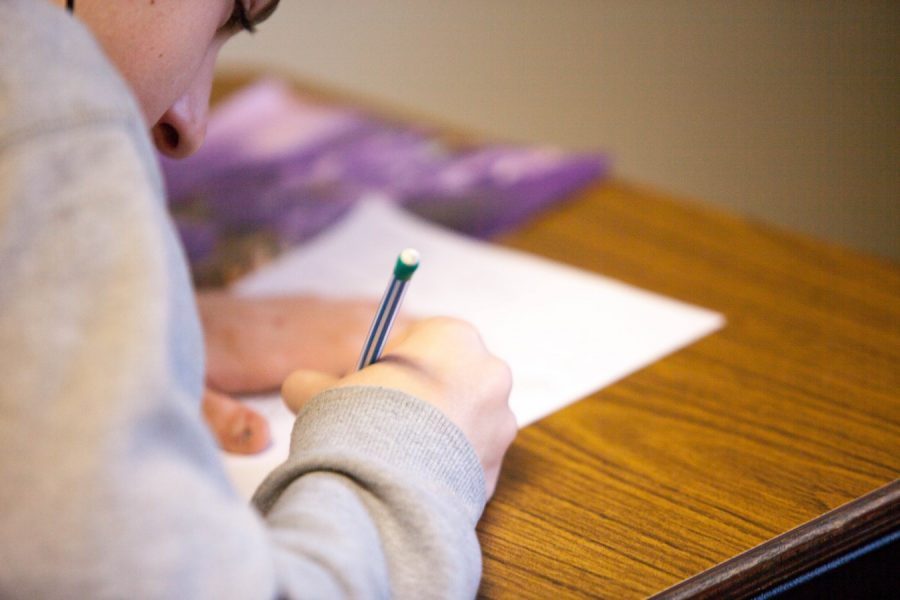Education domination: how the U.S. is behind in educational practices
March 12, 2019
Every few years there is a study presented by the Organization for Economic Co-operation and Development (OECD). The study is the result of a test, in which over 540,000 fifteen-year-old students from 72 countries take, in order to see which country has better education in three specific subjects. Those three subjects being: math, reading, and science. The most recent one which came out four years ago in late 2015 showed some chilling results for the U.S.
In the 2015, the results showed the U.S. rank 40th in math (below average), 24th in reading, and 25th in science. That pales in comparison to countries like Singapore who was first in every category, and others like China, Finland, Canada and even Estonia who consistently ranked in, or around, the top ten. Though there is the fact that some of these are countries that practice monoculturalism, making it easier for them to find benefit in education for more people, it still is shocking to see one of the supposedly most powerful countries in the world, the United States, suffer from lack of better education.
Now that the facts are there, what is the reason for them? Well one thing is that education within the U.S. is reliant on is property taxes. Neighborhoods with a richer community income-wise pay more taxes than poorer communities. Since that tax money is used to go into services, such as schools, the less money a community has, the less money a school is given. In return, that can cause schools to not have enough money to pay teachers or spend on better tools for educational purposes, both of which can have drastic effects on how kids learn or how much they learn.
For example, according to National Public Radio (NPR), in the Chicago Ridge School District in Illinois, the average amount of money spent per student is $9,974 which is well below the national average of $11,841. However, in another district that is located only an hour north of it, one school surrounded by corporate offices in the affluent suburbs of Chicago, that being Rondout School, spends an average of $28,639 per student. This scenario is not solely seen in Chicago or Illinois, but all over the U.S. in almost every single state, the only exceptions being maybe New York, Wyoming, and Alaska. This has shown up in even Washington state, where the Renton School District spends a measly average of $8,988 per student, as opposed to the Skykomish School District which spends $46,787 instead.
So, how do other countries avoid this same problem?
Well one thing that makes a big difference for their education is better funding. In recent years, countries like Turkey, Israel, the UK, and Portugal have seen boosts in education funding rise by 76%, 36%, 32% and 27%, respectively. Instead of joining these countries in the up-rise, the U.S. has seen funding decline by 3% in total spending and a 4% decline in spending per student.
Another factor that affects how much better education does in other parts of the world is better techniques of teaching. For example, Singapore, the leading country in all aspects of education, has a system which is described in an article done by The Conversation.
“Over time, Singapore has developed a powerful set of institutional arrangements that shape its instructional regime. Singapore has developed an education system which is centralised (despite significant decentralisation of authority in recent years), integrated, coherent and well-funded. It is also relatively flexible and expert-led. In addition, Singapore’s institutional arrangements is characterised by a prescribed national curriculum. National high stakes examinations at the end of primary and secondary schooling stream students according to their exam performance and, crucially, prompt teachers to emphasise coverage of the curriculum and teaching to the test. The alignment of curriculum, assessment and instruction is exceptionally strong.”
All of this combined makes Singapore the educational powerhouse that it is today. Many wonder why the U.S. doesn’t just take on this strategy in order to improve the country’s education, but what they don’t see is that it isn’t quite as simple as it seems. In fact, in that same article, it also says how much Singapore bases its education on its culture, with many historical and institutional influences being present within the system. This alone makes it nearly impossible for the same system to be transferable to other nations.
Another country that has become well known for its healthier approach to education is the Nordic country Finland.
According to Big Think’s website, it states, “Finland is leading the way because of common-sense practices and a holistic teaching environment that strives for equity over excellence.”
It’s true, and it has been shown to have positive results, with Finland ranking 13th in math, 4th in reading, and 5th in science on the PISA test. Recently they have been catching up to some of the leading Asian countries, while using different strategies–strategies that the U.S. could incorporate into its own system. One of the most defining aspects of Finland’s education system, as stated before, is the focus on students’ well-being. Since the 1980s, Finland has mainly focused on five ideals.
- Education should be an instrument to balance out social inequality
- All students receive free school meals
- Ease of access to health care
- Psychological counseling
- Individualized guidance
Some of the most crucial ones in this list are both psychological counseling and the balance to social inequality, as that is something many U.S. schools struggle with time and time again. Part of the reason for the need for psychological counseling is the stress both standardized testing and homework put on students, which if overlooked, could eventually lead to depression and suicide rates in teens increasing exponentially.
How does Finland solve this? They simply don’t give out tests or homework. Instead, the country’s focus is more towards individual achievements. All student within Finland are graded on an individualized basis by their teachers, while the overall progress of the students is tracked by the Ministry of Education. This way, students are encouraged to learn at their own rates and don’t feel like they have failed if not up to speed with the rest of the class. Along with that, students are taught and encouraged to cooperate, not compete in their studies, something that is common among students in American schools.
Now unlike the strategies employed within Singapore’s school system, the methods used by Finland could easily be utilized by the U.S., so why don’t they just do that and solve the entire problem?
Well, as it turns out, that is also not too simple. This is because of one shocking, horrifying reason that has angered many people, whether it be students, staff, or parents of students. That reason being that there are those who make money off of the standardized testing that is so essential to the culture of American schools, and that students are required to take.
There are several companies and individuals who oversee the standardized tests given out to students in the United States. One of those individuals being Gaston Caperton, non-profit owner of the SAT, who at one point made over 1.3 million dollars. He, however, pales in comparison to the companies who generate much more value.
One of them, Pearson Education, reportedly makes over 9 billion dollars annually off of the tests it gives out and holds control over 60% of the U.S. testing market. Those same tests, however, have been known to have severe problems such as questions that were considered invalid due to having errors or just being downright confusing. Not only that, but Pearson has been caught posting ads on Craigslist, looking for people to help grade the exams of students. One other thing to note about these tests is that students, particularly younger ones, have been reported to have thrown-up or cried during these tests due to just how worried they are over possibly failing.
All of this, however horrifying it may be, is still sadly true. In the end, the total value of the testing market is said to range from 400 to 700 million USD.
With the combined fact of how corrupt standardized testing is, the methods used by companies who supply it, how children and teens have suffered from it, and how the United States’ rating in education has seen a decrease in recent years, you’d think that many would take action against this. The only problem with that is that many aren’t educated about that, no pun intended. With the next PISA results set to be released sometime in December of this year, we’ll just have to see how much of an impact our country has experienced since the last one.
Sources:
- https://bigthink.com/mike-colagrossi/no-standardized-tests-no-private-schools-no-stress-10-reasons-why-finlands-education-system-in-the-best-in-the-world
- https://www.businessinsider.com/pisa-worldwide-ranking-of-math-science-reading-skills-2016-12
- https://nces.ed.gov/surveys/pisa/
- https://www.npr.org/2016/04/18/474256366/why-americas-schools-have-a-money-problem
- https://hechingerreport.org/rest-world-invests-education-u-s-spends-less/
- https://theconversation.com/why-is-singapores-school-system-so-successful-and-is-it-a-model-for-the-west-22917
- https://www.youtube.com/watch?v=J6lyURyVz7k
- https://www.huffingtonpost.com/rainesford-alexandra/the-business-of-standardi_b_9785988.html
- https://www.alternet.org/2013/07/corporations-profit-standardized-tests/
- https://www.washingtonpost.com/news/answer-sheet/wp/2015/05/07/pearson-responds-to-criticism-about-its-standardized-tests/?noredirect=on&utm_term=.389af73bf19c
- https://nces.ed.gov/surveys/pisa/schedule.asp






